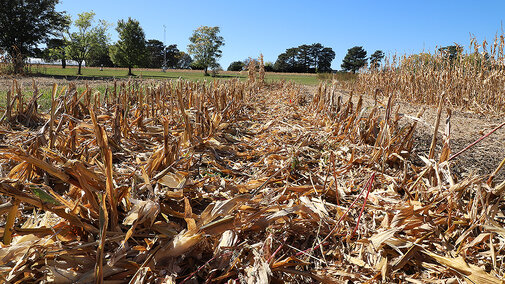Forage Options with Return of Rain
When there is rain, there is opportunity. Although welcome rains have finally reached most of Nebraska, it may have been too late to rescue some severely stressed row crops. Still, these rains have created opportunities for new crop seeding plans to take full advantage of the moisture. When drought limits row crop yields, many producers seek dual purpose forages which can provide both forage and cash grain income. Wheat is one of those dual-purpose crops providing forage grazing as well as a potential early summer cash grain income. To get full benefits, grazing animals will need to be removed in the spring from the fields prior to the wheat reaching the jointing growth stage.
This fall, the recommended winter wheat seeding dates for grain optimum production vary across Nebraska based on elevation (from Sept. 1 in the extreme northwest to Oct. 1 in the southeastern tip). For central Nebraska, the normal wheat drilling season is Sept. 20 to Sept. 25. This target date might be delayed to the last week of September if producers select wheat varieties susceptible to the Hessian Fly insects.
If forage production is the main goal, then earlier fall drilling is highly encouraged. Oats, barley, turnips and radishes especially benefit from early fall planting, whereas rye, triticale and wheat can be drilled later into the fall with success. Nebraska Extension research reveals, though, that total forage production doubles for each month earlier in the fall the forage crops can be planted.
Reversing Nitrate Toxicity
Besides limiting forage production, dry weather can create another problem for producers to deal with — nitrate toxicity. With drought-stricken areas of the state receiving some much-needed moisture lately, does the risk of nitrate poisoning go away?
Nitrogen is an element essential for growth in all forms of life. Plants, in particular, typically absorb nitrogen in the form of nitrate from the soil, transporting it from the roots to actively growing portions of the plant above ground. Once the nitrogen is moved into the leaves, then the nitrate can be changed into useful carbohydrates through sunlight and the photosynthesis process.
When dry conditions slow or halt plant growth, this pathway hits a dead end on the delivery side. Nitrate continues to be absorbed but, with no place to go, builds in concentration in lower portions of the stem. While all plants can exhibit nitrate toxicity during dry weather, grasses like our small grain species (rye, oats, wheat, triticale) and forage species (sorghums, millets, sudangrass) are particularly susceptible.
With the return of precipitation and additional plant growth, nitrates once again have a place to go as plants recover. While this imbalance will eventually correct itself, the process will take time; it is recommended to wait at least three days (after a significant drought ending rain event) before harvesting forage. This may allow the stressed plants to convert the potentially toxic nitrate levels into usable carbohydrates. Plants still displaying characteristics of stress will most likely still be carrying a higher-than-normal nitrate load. If you have any doubts, it’s better to be safe and send a sample to a reputable lab for testing.
The take home: nitrates accumulated in forages during drought can be reduced with the return of precipitation, but this process takes time. Wait for plants to fully resume normal growth and if in doubt, test.
Early Harvest for Early Corn Stalks
By Brad Schick
With many pastures short, high hay prices and stressed crops maturing more quickly, harvesting some corn a little early could provide corns stalks for grazing or baling.
Even with parts of the state catching some much-needed rain recently, pastures are short and most probably won’t recover like we think they will. The added pressure on the pastures is not good for them. Pastures need a break to recover and allow some important sugar storage in order to overwinter and have good growth next year. If the pastures get overgrazed too much, next year will be even worse. Even if we continue to receive some rain this fall and get good moisture going into winter, those pastures have been stressed pretty heavily this year and grazing too long even with good growth will affect the spring green-up.
Although this option can’t work for everyone, harvesting some corn a little early and utilizing earlier stalks will help relieve the pressure on the pastures. In addition, the earliest stalks typically have the highest protein and energy to either improve body condition of dry cows or keep growing calves growing at least for a while before supplementation is needed.
One of the biggest concerns with putting out to stalks during harvest is the time and labor needed to put up fence and situate the water. Although it takes away from harvest, it might be better for the cows and for the pasture they won’t overgraze.

